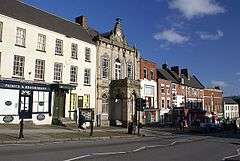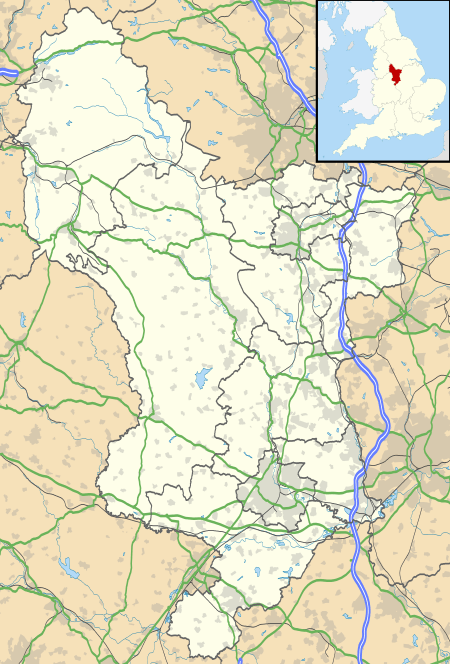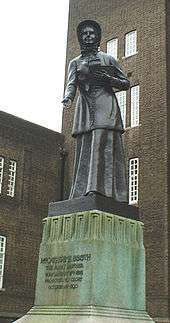Ashbourne, Derbyshire
Ashbourne is a market town in the Derbyshire Dales, England, with a population of 8,377 in the 2011 census. It contains many historical buildings and independently owned shops, and offers a historic annual Shrovetide football match. Its position near the southern edge of the Peak District makes it the closest town to Dovedale, to which it is sometimes referred as the "gateway".
| Ashbourne | |
|---|---|
 Market Hall, Buxton Road | |
 Ashbourne Location within Derbyshire | |
| Population | 7,112 (Parish, 2011)[1] |
| OS grid reference | SK1846 |
| Civil parish |
|
| District | |
| Shire county | |
| Region | |
| Country | England |
| Sovereign state | United Kingdom |
| Post town | ASHBOURNE |
| Postcode district | DE6 |
| Dialling code | 01335 |
| Police | Derbyshire |
| Fire | Derbyshire |
| Ambulance | East Midlands |
| UK Parliament | |

History
Ashbourne was granted a market charter in 1257.[2] In medieval times it was a frequent rest stop for pilgrims walking "St Non's Way" to the shrine at Dunstable in Bedfordshire.
The forces of Charles Edward Stuart passed through Ashbourne during the Jacobite rising of 1745.[3]
Governance
Ashbourne Town Council is made up of four wards, Belle Vue, Hilltop, Parkside and St Oswald's, represented by a total of 13 councillors. It meets in the Market Place town hall.
Geography
Ashbourne lies at 53°01′N 01°44′W. Ashbourne Green and Sturston are hamlets close by. Henmore Brook, a tributary of the River Dove, flows through the middle of the town. It has an elevation of 400 feet (122 m).[4]
Demography
Ashbourne has a population of 8,377 according to the 2011 census.[5]
Economy
From 1910, Nestlé had a creamery in the town, which for a period was contracted to produce Carnation condensed milk. The factory had its own private sidings connected to the railway station goods yard, which allowed milk trains to access the facility, and distribute product as far south as London. After milk trains ceased in 1965, the railway track was lifted and the railway station closed. The factory closed in 2003, and since demolition in 2006, has been redeveloped as housing and a light industrial estate, although the old loading ramp from street level up to the factory floor is still in place.
Water from a borehole on the site was first marketed as Ashbourne Water in 1975, and was sold mostly to the catering trade.[6] Nestlé retained the borehole after the factory shut, taking water by tanker to Buxton for bottling.[6] Declining sales (1.3 million bottles in 2005, compared to 90 million for Buxton water) meant it could not justify further investment and the brand was discontinued in 2006.[6]
Tourism is an important element of the local economy, stemming from the town's proximity to Dovedale and the Peak District. The Tourist Information Centre was threatened with closure in 2011,[7] but from January 2018, a Visitor Information Centre was available in the Town Hall.[8]
Culture and community
.jpg)
The cobbled market place hosts a traditional outdoor market every Thursday and Saturday throughout the year, complementing the wide range of individual shops in the town. Although its market heritage is important, it came under threat of closure from Derbyshire County Council in November 2012. The people of Ashbourne have opposed any such moves by the council and started an online petition. Ashbourne became the 97th Fairtrade Town in March 2005 after many businesses, cafes, shops and community organisations started supporting Fairtrade.[9]
Ashbourne Shire Horse Society and Ashbourne Show
According to the Ashbourne Show website:[10]
"In 1881, four gentlemen founded a society, with the aim of improving the standard of Shire horses in the Ashbourne area. Originally known as the Ashbourne Cart Horse Society, later that year, they held their first a show on the Paddock, at Ashbourne. This was so successful, it was determined by public meeting to put the show on a permanent basis and apart from a few years lost to war and foot-and-mouth, an annual show has been held ever since. In 1888, the title Ashbourne Shire Horse Society was adopted and royal patronage was granted in 1899 by King Edward VII, who was President in 1901. Shrovetide Football although much older, did not become royal till 1928. Although there have been ups and downs over the years, the ambition of the founders has been fully justified. It has grown, changed and evolved, with cattle introduced in 1925 and sheep in 1957. Other sections have also been added, so that it has become the modern Ashbourne Show, now presented by the Ashbourne Shire Horse Society. However, what has not changed is the aim and ambition to produce a show for the encouragement of excellence in agriculture and animal husbandry and for the information education and entertainment of the local community and the visitors to the area each August."
Landmarks
.jpg)
Ashbourne currently has eleven public houses and two social clubs. The most famous, the Green Man & Black's Head Royal Hotel, closed in 2011 and underwent a change of ownership in 2013, before reopening in 2018.[11] The rare gallows sign across St John's Street remains a meeting point in the town. In June 2020, the caricature of a black man's head atop the sign became the focus of racial debate.[12] It was removed after a petition had gathered more than 40,000 signatures, but it is being preserved locally.[13][14]
Transport
The Tissington Trail, a popular recreational walk and cycle path, starts at Mappleton Lane on the northern outskirts of town, accessed by a large Victorian tunnel about 380 yards long from the site of the former railway station. It follows the course of the former Ashbourne to Buxton railway through the village of Tissington and joins the High Peak Trail (the old Cromford and High Peak Railway) at Parsley Hay.
Construction of the Ashbourne to Buxton line commenced in 1896.[15] Passenger services started to Buxton in August 1899 after the building of a joint railway station to serve both the London and North Western Railway (LNWR) and North Staffordshire Railway (NSR) lines. The line closed to regular passenger traffic in 1954, and all services on the Ashbourne–Parsley Hay section ceased in 1963. The line continued down the Dove to Rocester near Uttoxeter, where it joined the main North Staffordshire Railway. This southern link had opened in 1852.[16] and in 1867 the LNWR gained running powers over the line. It also closed to passengers in 1954 and completely in the early 1960s.

Today the nearest railway stations are Uttoxeter, 12 miles away on the Crewe-Derby Line, and Derby, 13 miles away. There are buses from Derby to Uttoxeter every half hour, other buses to Matlock, Leek, Buxton, Nottingham and Wirksworth, and one a day to Burton.
The Limestone Way passes 2–3 miles away, through Tissington, Thorpe, Marten Hill and above Mayfield to Rocester.[17][18][19] There are several routes that take walkers from Ashbourne to Limestone Way.
Education
The main secondary school is Queen Elizabeth's Grammar School, founded in 1585. It moved to its current site on the Green Road in 1909, and took over Ashbourne County Secondary School in 1973.
Religious sites
The 215 ft (66 m) spire of St Oswald's Church dominates the town. The church is Early English in style and was built around 1220. There are a few remnants of earlier Norman construction and in the south aisle is part of a Saxon cross shaft. The church of St John was built on Buxton Road in 1871 in a neo-Norman style. Ashbourne Churches Together (ACT) has a link with the Diocese of Patna in the ecumenical Church of North India.[20] Regular reciprocal visits take place. Members of ACT are currently sponsoring the education of children in a school in Bihar, one of the poorest states in India.
Sport
The annual two-day Royal Shrovetide Football Match has one half of the town plays the other, using the town as the pitch, with goals three miles apart. As many as several thousand players compete for two days with a hand-painted, cork-filled ball. The game is played by two teams, the Up'ards and the Down'ards, over two eight-hour periods, subject to few rules. Shrovetide football has been played for several centuries. It is a moving mass (the Hug) which continues through the roads of the town, across fields and even along the bed of the local Henmore Brook. There were intermittent unsuccessful attempts to ban the game until the late 19th century.
Before the 1966 Football World Cup, the West German squad stayed at the nearby Peveril of the Peak Hotel and trained on one of Ashbourne's town football pitches near the park.
Local contestant Dave Mellor was the 1978 BriSCA Formula 1 Stock Cars World Champion.[21]
Notable people
- Sir Brooke Boothby, 6th Baronet, poet, was born here in 1704.[22]
- Catherine Booth, known as the "mother" of the Salvation Army', was born here in 1829.[23]
- Hill Boothby, late love of Samuel Johnson, was born here in 1708.[24]
- Thomas Brown, Garter King of Arms, was born here in 1708.
- Henry Cantrell, clergyman and religious controversialist, was born here in 1684.[25]
- Sir Aston Cockayne, 1st Baronet Cockayne of Ashbourne
- William Corden the Elder (1795–1867), portrait painter
- George Hayne (died 1723), merchant and entrepreneur
- Francis Charles Robert Jourdain (1865–1940), ornithologist, was born in Ashbourne in 1865 and for a time served as Vicar of Clifton-by-Ashbourne.
- Andrew Lewer (born 1971), East Midlands MEP, lived in Ashbourne and attended Queen Elizabeth's Grammar School, Ashbourne.
- Catherine Pegge was mistress to Charles II, mother to Charles FitzCharles, 1st Earl of Plymouth, and a resident of Yeldersley
- David Redfern (1935–2014), photographer
- James Rutledge (born 1978), musician and producer
- Dave Tyack (1978–c. 2002), guitarist, drummer and singer
- Roy Wood, musician, lives here.

References
- "Neighbourhood Statistics". Office for National Statistics. Archived from the original on 23 October 2014. Retrieved 18 October 2014.
- Ashbourne Granted Market Charter
- "A general ACCOUNT of the Conduct and Proceedings of the REBELS during their Stay at DERBY". Derby Mercury. 29 November 1745. Retrieved 26 December 2015 – via findmypast.
- OS Explorer map: 259: Derby (Map). Ordnance Survey.
- "Ashbourne (Derbyshire, East Midlands, United Kingdom) – Population Statistics and Location in Maps and Charts". www.citypopulation.de. Retrieved 21 September 2016.
- "Sales decline shuts Ashbourne Water". Ashbourne News Telegraph. 3 May 2006.
- "Ashbourne and Matlock tourist information centres set to close". BBC News. 12 December 2011. Retrieved 28 January 2018.
- "Tourist Information Office". Ashbourne Town Council. Archived from the original on 29 January 2018. Retrieved 28 January 2018.
- Ashbourne Fairtrade Town Initiative.
- "Aims of the Society". The Ashbourne Show. Retrieved 18 May 2015.
- "A sneak peek inside Ashbourne's new Green Man pub". Derby Telegraph. 27 July 2018.
- "Black man's head pub sign to go in racism row in Ashbourne". BBC News. 8 June 2020. Retrieved 9 June 2020.
- "Ashbourne black man's head pub sign removed amid racism row". BBC News. 9 June 2020. Retrieved 9 June 2020.
- Bland, Archie (9 June 2020). "Derbyshire town's 'racist' bust that faced removal hidden by residents". The Guardian. Retrieved 9 June 2020.
- Bentley & Fox, J. M. & G. K. (1997). Railways of the High Peak Buxton to Ashbourne. Stockport UK: Foxline Publishing. p. 8. ISBN 1-870119-45-2.
- Kingscott, Geoffrey (2007). Lost Railways of Derbyshire. Newbury Berkshire UK: Countryside Books. p. 63. ISBN 978-1-84674-042-8.
- Derbyshire Dales District Council. The Limestone Way Walkers Guide. Matlock UK: Tourism Section DDDC. pp. 22–25.
- Ordnance Survey (2009). Explorer OL24. Southampton UK: Ordnance Survey. ISBN 978-0-319-24111-0. and Ordnance Survey (2008). Explorer 259. ISBN 978-0-319-23725-0.
- Long Distance Walkers Association. "Limestone Way". Archived from the original on 24 March 2013. Retrieved 7 March 2013.
- "The Patna Partnership". Ashbourne Churches Together. Archived from the original on 11 August 2013. Retrieved 7 March 2013.
- "World Championship". F1 Stockcars. Retrieved 28 January 2018.
- Rebecca Mills, "Boothby, Sir Brooke, seventh baronet (1744–1824)", Oxford Dictionary of National Biography, Oxford University Press, 2004; online edition, May 2010 accessed 2 January 2017
- "Catherine Booth Biography". s9.com. Archived from the original on 28 May 2007. Retrieved 19 October 2016.
- Kathryn M. Burton, "Boothby, Hill (1708–1756)", Oxford Dictionary of National Biography, Oxford University Press, 2004 accessed 2 January 2017.
- David L. Wykes, "Cantrell, Henry, Church of England clergyman and religious controversialist" Oxford Dictionary of National Biography, Oxford University Press, 2004.
External links
| Wikimedia Commons has media related to Ashbourne. |
| Wikivoyage has a travel guide for Ashbourne. |